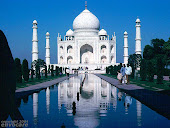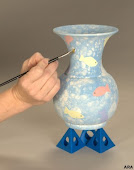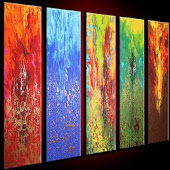main |
sidebar

She painted numerous pictures of strong and suffering women from myth and the Bible – victims, suicides, warriors – and made a speciality of the Judith story. Her best-known image, Judith Beheading Holofernes shows the decapitation of Holofernes, a scene of terrible struggle and blood-letting. That she was a woman painting in the 17th century and that she was raped herself and participated in prosecuting the rapist long overshadowed her achievements as an artist. For many years she was regarded as a curiosity. Today she is regarded as one of the most progressive and expressionist painters of her generation.
In Florence, Artemisia enjoyed enormous success. She was the first woman accepted into the Accademia delle Arti del Disegno. She maintained good relations with the most respected artists of her time, such as Cristofano Allori, and was able to garner the favours and the protection of influential people, starting with Granduke Cosimo II de' Medici and especially of the Granduchess Cristina.
The first author who produced a novel around the figure of Artemisia was Anna Banti, wife of Roberto Longhi. Her first draft of the manuscript, dated 1944, was lost throughout the war. Three years later she started again with the book, to be called Artemisia, writing in a much different form. Banti's book is written in an "open diary" form, in which she maintains a dialogue with Artemisia, trying to understand why she finds her so fascinating.
More than 50 years later, in 1999, the French writer Alexandra Lapierre became fascinated by Artemisia and wrote a novel about her, derived from scrupulous study of the painter and the historical context of her work.

It was first erected in 1755 throughout the reign of the Qianlong Emperor. The original pavilion was made from a base of huge stone blocks which supported a wooden superstructure done in a traditional Chinese design.
In 1860, throughout the Second Opium War, the pavilion was destroyed by Anglo-French forces. It was restored in 1893 on order of the Empress Dowager Cixi. In this restoration, a new two-story superstructure was designed which incorporated elements of European architecture.
The boat design of the pavilion can relate to a quote attributed to Wei Zheng, a chancellor of the Tang Dynasty renowned for his honest advice. He is said to have told the emperor "the waters that float the boat can also swallow it", implying that the people will support the emperor but can also topple him. With this in mind, Emperor Qianlong might have chosen to construct the Marble Boat on a solid stone base to point out that the Qing Dynasty was not to be overthrown.
The Marble Boat is often seen as an ironic commentary on the actual fact that the money used to restore the Summer Palace largely came from funds originally earmarked for building up a new imperial navy. The controller of the Admiralty, Prince Chun, owed much of his social standing as well as his appointment to the Empress Dowager, who had adopted his oldest son to become the Guangxu Emperor. Because of this, he probably saw no other alternative than to condone the embezzlement.
The pavilion is 36 meters long. It stands on the northwestern shore of Kunming Lake, near the western end of the Long Corridor.

The essence of Gabo's art was the exploration of space which he believed may be done without having to depict mass. His earliest constructions such as Head No.2 were formal experiments in depicting the volume of a figure without carrying its mass. Gabo's other concern as described in the Realist Manifesto was that art required to exist actively in four dimensions including time.
Gabo's childhood years were in Munich, where he was impressed by and actively participated in the artistic, scientific, and philosophical debates of the early years of the 20th century. Because of his involvement in these intellectual debates, Gabo became a number one figure in Moscow’s avant garde, in post-Revolution Russia.
It was in Munich that Gabo attended the lectures of art historian Heinrich Wolff in and gained information of the ideas of Einstein and his fellow innovators of scientific theory, also the philosopher Henri Bergson.

The Cathedral of the Annunciation was built by architects from Pskov in 1484-1489 as part of Grand Duke Ivan III plans for a large-scale redecoration of the Moscow Kremlin. It was built on the spot of an older 14th century cathedral of the same name, which had been reconstruction in 1416. This older cathedral in turn had replaced a previous wooden church from the 13th century that had fallen victim to the regular fires in the Kremlin.
Compared with the other two major Kremlin cathedrals, the Annunciation Cathedral has slightly smaller dimensions. It is also built in a more traditional style, as it was created by local architects from Pskov, rather than Italian emigrant architects. The most characteristic feature of the building is its nine beautiful golden domes, and roof with rich kokoshnik ornamentation in an ogive form.
The Cathedral was built of brick, with facades of white limestone that are decent and decorated. There are entrances to the cathedral on the eastern and also the southern side of the building, with fretwork influenced by Italian Renaissance architecture.
The interior of the cathedral consists of the central prayer area and several surrounding galleries, with the additions of side altars in the 16th Century. The northern is the first gallery space, which is entered through the visitor entrance.











Online Paintings
Monday, October 15, 2012
The Lexington Stars - the Might Town Royalty new Category A online in the Southern Ocean Group - lately revealed a product new shade plan, consistent style and logo to match with their organization modify. And when we say product new, we mean it, because Lexington will become the first minor-league football group to put on lotion, elegant red and kelly felix natural shade blends. That is exclusive to say the least.
Oh, and we should also discuss they'll become the first group to function a mustache logo all by itself on one of their three new hat styles, because let's be sincere, who wouldn't want to own or use a hat noticeably presenting a mustache
They definitely prevailed in providing on the wow aspect, because again, their additional pet mascot logo design is a mustache. But that aspect aside, they also provided during the huge introduction wedding by having their pet and inspiration for the new logo, the mustachioed Big L, rappel 410 legs down the side of the Lexington Financial Middle while dressed in the new styles.
As for the Legends' main logo in 2013, gm Seth Poteat says that will still function a scowling Big L with football softball bats traversing behind his go, so they haven't strayed too far away from their identification. But at first they weren't even sure if they desired to upgrade or modify the logo at all as a aspect of the style up-dates.
Saturday, August 11, 2012
The Pleven Regional Historical Museum has its roots in the local Archaeological Society founded in 1903, the goals of which included the creation of a museum, as well as the discovery and investigate of historical monuments in the town and the area. The first excavations of the Roman fortress of Storgosia in Kaylaka Park in May 1905 were organized and carried out by the society under the direction of Yurdan Kantardzhiev.

A museum collection that exhibited the items found was assembled by the society in 1911. In 1923, all the materials were moved to the Saglasie Community Centre, where a museum was established.
Officially founded in 1953, the museum moved to its current construction, built between 1884 and 1888 after an Italian project for barracks, in 1984.
The museum became regional on 1 July 2000, embracing the provinces of Pleven and Lovech.

A museum collection that exhibited the items found was assembled by the society in 1911. In 1923, all the materials were moved to the Saglasie Community Centre, where a museum was established.
Officially founded in 1953, the museum moved to its current construction, built between 1884 and 1888 after an Italian project for barracks, in 1984.
The museum became regional on 1 July 2000, embracing the provinces of Pleven and Lovech.
Friday, June 15, 2012

Artemisia Gentileschi was an Italian Baroque painter, nowadays considered one of the most accomplished painters in the generation after Caravaggio. In an era when women painters were not easily accepted by the artistic community or patrons, she was the first female painter to become a member of the Accademia di Arte del Disegno in Florence.
She painted numerous pictures of strong and suffering women from myth and the Bible – victims, suicides, warriors – and made a speciality of the Judith story. Her best-known image, Judith Beheading Holofernes shows the decapitation of Holofernes, a scene of terrible struggle and blood-letting. That she was a woman painting in the 17th century and that she was raped herself and participated in prosecuting the rapist long overshadowed her achievements as an artist. For many years she was regarded as a curiosity. Today she is regarded as one of the most progressive and expressionist painters of her generation.
In Florence, Artemisia enjoyed enormous success. She was the first woman accepted into the Accademia delle Arti del Disegno. She maintained good relations with the most respected artists of her time, such as Cristofano Allori, and was able to garner the favours and the protection of influential people, starting with Granduke Cosimo II de' Medici and especially of the Granduchess Cristina.
She had a good relationship with Galileo Galilei with whom she remained in epistolary contact for a long time. She was esteemed by Michelangelo Buonarroti the younger busy with construction of Casa Buonarroti to celebrate his notable relative, he asked Artemisia to produce a painting to decorate the ceiling of the gallery of paintings.
The first author who produced a novel around the figure of Artemisia was Anna Banti, wife of Roberto Longhi. Her first draft of the manuscript, dated 1944, was lost throughout the war. Three years later she started again with the book, to be called Artemisia, writing in a much different form. Banti's book is written in an "open diary" form, in which she maintains a dialogue with Artemisia, trying to understand why she finds her so fascinating.
More than 50 years later, in 1999, the French writer Alexandra Lapierre became fascinated by Artemisia and wrote a novel about her, derived from scrupulous study of the painter and the historical context of her work.
Friday, April 20, 2012

The Marble also identified as the Boat of Purity and Ease is a lakeside pavilion on the grounds of the Summer Palace in Beijing, China.
It was first erected in 1755 throughout the reign of the Qianlong Emperor. The original pavilion was made from a base of huge stone blocks which supported a wooden superstructure done in a traditional Chinese design.
In 1860, throughout the Second Opium War, the pavilion was destroyed by Anglo-French forces. It was restored in 1893 on order of the Empress Dowager Cixi. In this restoration, a new two-story superstructure was designed which incorporated elements of European architecture.
Like its predecessor, the new superstructure is made out of wood but it was absolutely painted to imitate marble. On each "deck", there is a large mirror to reflect the waters of the lake and give an impression of total immersion in the aquatic surroundings. Imitation paddlewheels on every side of the pavilion makes it look like a paddle steamer. The pavilion has a sophisticated drainage system which channels rain water through four hollow pillars. The water is lastly released into the lake through the mouths of four dragonheads.
The boat design of the pavilion can relate to a quote attributed to Wei Zheng, a chancellor of the Tang Dynasty renowned for his honest advice. He is said to have told the emperor "the waters that float the boat can also swallow it", implying that the people will support the emperor but can also topple him. With this in mind, Emperor Qianlong might have chosen to construct the Marble Boat on a solid stone base to point out that the Qing Dynasty was not to be overthrown.
The Marble Boat is often seen as an ironic commentary on the actual fact that the money used to restore the Summer Palace largely came from funds originally earmarked for building up a new imperial navy. The controller of the Admiralty, Prince Chun, owed much of his social standing as well as his appointment to the Empress Dowager, who had adopted his oldest son to become the Guangxu Emperor. Because of this, he probably saw no other alternative than to condone the embezzlement.
The pavilion is 36 meters long. It stands on the northwestern shore of Kunming Lake, near the western end of the Long Corridor.
Tuesday, April 10, 2012

Naum Gabo KBE, born Naum Neemia Pevsner (5 August [24 July] 1890 – 23 August 1977) was a famous Russian sculptor in the Constructivism movement and a pioneer of Kinetic Art. Gabo grew up in a Jewish family of six children in the provincial Russian town of Bryansk, where his father owned a factory.
His older brother was fellow Constructivist artist Antoine Pevsner; Gabo modified his name to avoid misunderstanding with him. Gabo was a fluent speaker and writer of German, French, and English in addition to his native Russian. His command of many languages contributed greatly to his mobility during his career. “As in thought, so in feeling, a vague communication is not any communication at all," Gabo once remarked.
Gabo’s Theory of Art:
The essence of Gabo's art was the exploration of space which he believed may be done without having to depict mass. His earliest constructions such as Head No.2 were formal experiments in depicting the volume of a figure without carrying its mass. Gabo's other concern as described in the Realist Manifesto was that art required to exist actively in four dimensions including time.
Gabo's childhood years were in Munich, where he was impressed by and actively participated in the artistic, scientific, and philosophical debates of the early years of the 20th century. Because of his involvement in these intellectual debates, Gabo became a number one figure in Moscow’s avant garde, in post-Revolution Russia.
It was in Munich that Gabo attended the lectures of art historian Heinrich Wolff in and gained information of the ideas of Einstein and his fellow innovators of scientific theory, also the philosopher Henri Bergson.
As a student of medicine, natural science and engineering, his understanding of the order present in the natural world mystically links all creation in the universe. Just before the onset of the First World War in 1914, Gabo discovered fashionable art, by reading Kandinsky’s Concerning the Spiritual in Art, which asserted the principles of abstract art.
Friday, March 30, 2012

The Cathedral of the Annunciation is a Russian traditional Church dedicated to the Annunciation of the Theotokos. It is located on the southwest side of Cathedral Square of the Moscow Kremlin in Russia, where it connects directly to the main building of the difficult of the Grand Kremlin Palace, adjacent to the Palace of Facets. It was originally the personal chapel for the Muscovite tsars, and its abbot remained a individual confessor of the Russian royal family until the early 20th century.
The Cathedral of the Annunciation was built by architects from Pskov in 1484-1489 as part of Grand Duke Ivan III plans for a large-scale redecoration of the Moscow Kremlin. It was built on the spot of an older 14th century cathedral of the same name, which had been reconstruction in 1416. This older cathedral in turn had replaced a previous wooden church from the 13th century that had fallen victim to the regular fires in the Kremlin.
Compared with the other two major Kremlin cathedrals, the Annunciation Cathedral has slightly smaller dimensions. It is also built in a more traditional style, as it was created by local architects from Pskov, rather than Italian emigrant architects. The most characteristic feature of the building is its nine beautiful golden domes, and roof with rich kokoshnik ornamentation in an ogive form.
The Cathedral was built of brick, with facades of white limestone that are decent and decorated. There are entrances to the cathedral on the eastern and also the southern side of the building, with fretwork influenced by Italian Renaissance architecture.
The bronze doors are decorated with gold foil. Tourists enter the cathedral via the eastern staircase, while the southern staircase is that the one added in 1570 by Ivan the Terrible. The relatively high entrance is due to the very fact that the building was built on the raised base of its predecessor.
The interior of the cathedral consists of the central prayer area and several surrounding galleries, with the additions of side altars in the 16th Century. The northern is the first gallery space, which is entered through the visitor entrance.
Wednesday, March 21, 2012

Hashim ud-Daula, Nawab Ja'afar Ali Khan Bahadur, Mahabat Jang commonly known as Mir Jafar, second son of Sayyid Ahmad Najafi, (1691–February 5, 1765) was Nawab of Bengal, Bihar and Orissa. He is also known by Indians as Gaddar-e-Abrar. He succeeded Siraj-Ud-Daulah as the eighth Nawab of Bengal, and the first of the Najafi dynasty after misleading Nawab Siraj-Ud-Daulah and surrendering his army in battle field against Robert Clive.
His rule is extensively considered the start of British rule in India and was a key step in eventual British domination of the country. His greed of becoming Nawab of Bengal, led him to make a secret deal with Robert Clive and surrender & slaughter of Army of Bengal in Battle of Plessey, without fighting, which led to foundation of British rule in India. For this act of treachery, he has been infamously called Gaddar-e-Abrar. Gaddar means a traitor & Abrar means faith.
However, Mir Jafar had higher ambitions. Arrogant in his position he took advantage of an Ali Vardi Khan weakened by a decade of fighting with Marathas to enter into a conspiracy with Ataullah to overthrow and murder the Nawab. However, the conspiracy was unearthed and he was stripped of most of his powers. He came back to Murshidabad, where he regained the trust of the Nawab's grandson, Siraj-Ud-Daulah, and slowly returned to power and prominence.
After Siraj Ud Daulah’s defeat and subsequent execution, Mir Jafar achieved his long-pursued dream of gaining the throne, and was propped up by the British as puppet Nawab. Mir Jafar paid a sum of Rs. 17,700,000 as compensation for the attack on Calcutta to the company and the traders of the city. In addition, he paid large sums as gifts or bribes to the officials of the company.
Clive, for example received over two million rupees, Watts over one million Soon, however, he realized that British expectations were boundless and tried to move about out from under them; this time with the help of the Dutch.
However, the British defeated the Dutch at the Battle of Chinsurah in November 1759 and retaliated by forcing him to abdicate in favor of his son-in-law Mir Qasim. However, Mir Qasim proved to be able and independent, eager to live with but not bow to the British. The Company soon went to war with him, and he was eventually overthrown. Mir Jafar managed to regain the good graces of the British; he was again appointed Nawab in 1763 and held the position until his death in 1765.
;;
Subscribe to:
Posts (Atom)
Tajmahal Paintings

Painting Iteams

Creation of Paintings

Painting Equipments

Beautiful Rose Painting

Green Nature Painting

Canvas Painting

Pictute of Artist

Color Paintings

Online Paintings
